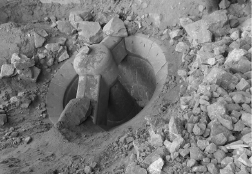Rotary crusher: innovative technology opens up new fields of ore processing
Rotary crusher
Recently, rotary crushers have attracted widespread attention in the ore processing industry. As an efficient and reliable crushing equipment, the rotary crusher will bring disruptive changes to ore processing.

A rotary crusher is a device that crushes materials in a rotating manner. Its unique design structure allows for the full utilization of the material's own gravity during the ore crushing process, thereby greatly improving the crushing efficiency. Compared to traditional crushing equipment, rotary crushers have a higher crushing ratio and lower energy consumption, which can better adapt to different types and hardness of ores.
This equipment adopts advanced hydraulic technology and has an automated control system that can intelligently adjust according to the characteristics of different ores, improving production efficiency and stability. In addition, the rotary crusher also has the advantages of low noise and environmental protection, effectively reducing the impact on the surrounding environment.
The emergence of rotary crushers will bring significant changes to the ore processing industry. It can efficiently crush ore, improve ore utilization, and reduce resource waste. At the same time, its low energy consumption and environmental protection characteristics also meet the current social demand for green development.
It is understood that the rotary crusher has been tested in multiple ore processing enterprises and has achieved significant results. The application of this innovative technology will further promote the upgrading and transformation of the ore processing industry.
Industry experts say that the emergence of rotary crushers marks a new stage in China's ore processing technology. I believe that with the continuous development and improvement of this technology, China's ore processing industry will usher in broader development prospects.
Summary: As an innovative technology, the rotary crusher has attracted enthusiastic attention in the ore processing industry due to its high efficiency and reliability. Its unique design structure and advanced hydraulic technology give it significant advantages in improving crushing efficiency and stability, while also meeting the current social demand for green development. The application of rotary crushers will promote the upgrading and transformation of the ore processing industry, opening up a new path for the development of ore processing technology in China.
 O'zbek
O'zbek slovenský
slovenský Azərbaycan
Azərbaycan Қазақ
Қазақ Latine
Latine ລາວ
ລາວ български
български नेपाली
नेपाली فارسی
فارسی Javanese
Javanese Українська
Українська Lietuvos
Lietuvos Română
Română Slovenski
Slovenski پښتو
پښتو Punjabi
Punjabi Bosanski
Bosanski Malti
Malti Galego
Galego Afrikaans
Afrikaans Esperanto
Esperanto 简体中文
简体中文 Српски
Српски मराठी
मराठी Ελληνικά
Ελληνικά čeština
čeština Polski
Polski ไทย
ไทย Nederlands
Nederlands Italiano
Italiano Tiếng Việt
Tiếng Việt Deutsch
Deutsch français
français русский
русский Português
Português Español
Español 한국어
한국어 Svenska
Svenska Malay
Malay اردو
اردو norsk
norsk Indonesia
Indonesia عربى
عربى Gaeilge
Gaeilge Türk
Türk Pilipino
Pilipino हिन्दी
हिन्दी Dansk
Dansk বাংলা
বাংলা English
English


What is a Metering Conveyor
In modern material handling systems, efficiency and precision are critical to maintaining smooth operations. Among the many specialized conveyors used in industries such as packaging, food processing, mining, and logistics, the metering conveyor plays a vital role. But what exactly is a metering conveyor, and why is it becoming increasingly important in production environments?
Read MoreJuli Engineering Gains Global Recognition Among Mining Conveyor Manufacturers
The mining industry relies heavily on efficient material handling systems to ensure productivity and safety in large-scale operations. Among the many solutions available, mining conveyors stand out as indispensable equipment for transporting bulk materials such as ore, coal, and aggregates. As demand for advanced solutions grows, Juli Engineering has established itself as one of the most reliable mining conveyor manufacturers, offering durable, high-performance systems tailored to global mining needs.
Read MoreDesign and Application of a Comprehensive Coal Spillage Handling System for Downwards Transportation Belt Conveyor
A belt conveyor with an annual production capacity of 3 million tons is installed in a main inclined roadway with a steep angle of 22°. During operation, issues such as coal overflow, spillage, and falling coal occur, particularly when transporting raw coal with high moisture content.
Read More